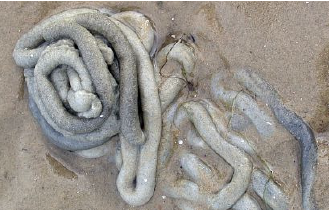Balanoglossus carnosus is a depositfeeder that has a straight, regionally specialized digestive tract thatlengthens from the mouth to the anus (Mandal, 2012).
With its muscular proboscis and its tongue, it is possible to catch sand and/ormud on surrounding and, therefore, obtain organic material and micro-organisms(Mandal, 2012). The mucus that it produces helps to catch the sediments (Marques, undated), which are moved to the mouththrough cilia currents (Biocyclopedia, 2012). These cilia currents help toswallow particles since they produce the flow of water in the mouth and eliminationof water through the gill pores (Mandal, 2012). Particles that are too large mightbe banned by covering the mouth with the borderof the collar (Biocyclopedia, 2012). After passing through the mouth, itgoes to the buccal tube and pharynx (Mandal, 2012). Posteriorly, it goes to theintestine that has a short oesophagus with pores that opens to the outside,helping in the removal of water (Marques,undated). The faecal compounds are transported through the posteriorintestine until it reaches the anus (Marques,undated) (figure 6)

Figure 6 - Food currents of enteropneust. A, Side view of acorn worm with mouth open, showing direction of currents origineted by cilia on proboscis and collar. Food particles are directed through the mouth and digestive tract. Rejected particles move through outside of collar. Water leaves through gill pores. B, When mouth is occluded, all particles are rejected and passed onto the collar. Nonburrowing and some burrowing hemichordates use this feeding method (Biocyclopedia, 2012)
The faecal compounds (figure 7), mostly sand and mucus, are eliminated through theanus (Bateson, 1883). The deposition of them forms spiral mounds of faeces,which can be used to identify the location of the burrows (Biocyclopedia, 2012)

Figure 7 - faeces compounds (Ferreira, undated)
This method of feeding permits Balanoglossus to dig their tunnels(Mandal, 2012).